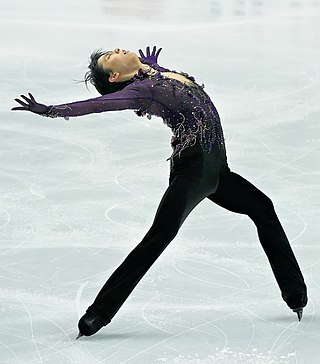
Figure skating is a sport in which individuals, pairs, or groups perform on figure skates on ice. It was the first winter sport to be included in the Olympic Games, when it was contested at the 1908 Olympics in London. The Olympic disciplines are men's singles, women's singles, pair skating, and ice dance; the four individual disciplines are also combined into a team event, which was first included in the Winter Olympics in 2014. The non-Olympic disciplines include synchronized skating, Theater on Ice, and four skating. From intermediate through senior-level competition, skaters generally perform two programs, which, depending on the discipline, may include spins, jumps, moves in the field, lifts, throw jumps, death spirals, and other elements or moves.

Spins are an element in figure skating in which the skater rotates, centered on a single point on the ice, while holding one or more body positions. They are performed by all disciplines of the sport, single skating, pair skating, and ice dance, and are a required element in most figure skating competitions. As The New York Times says, "While jumps look like sport, spins look more like art. While jumps provide the suspense, spins provide the scenery, but there is so much more to the scenery than most viewers have time or means to grasp". According to world champion and figure skating commentator Scott Hamilton, spins are often used "as breathing points or transitions to bigger things"

Compulsory figures or school figures were formerly a segment of figure skating, and gave the sport its name. They are the "circular patterns which skaters trace on the ice to demonstrate skill in placing clean turns evenly on round circles". For approximately the first 50 years of figure skating as a sport, until 1947, compulsory figures made up 60 percent of the total score at most competitions around the world. These figures continued to dominate the sport, although they steadily declined in importance, until the International Skating Union (ISU) voted to discontinue them as a part of competitions in 1990. Learning and training in compulsory figures instilled discipline and control; some in the figure skating community considered them necessary to teach skaters basic skills. Skaters would train for hours to learn and execute them well, and competing and judging figures would often take up to eight hours during competitions.
The Salchow jump is an edge jump in figure skating. It was named after its inventor, Ulrich Salchow, in 1909. The Salchow is accomplished with a takeoff from the back inside edge of one foot and a landing on the back outside edge of the opposite foot. It is "usually the first jump that skaters learn to double, and the first or second to triple". Timing is critical because both the takeoff and landing must be on the backward edge. A Salchow is deemed cheated if the skate blade starts to turn forward before the takeoff, or if it has not turned completely backward when the skater lands back on the ice.
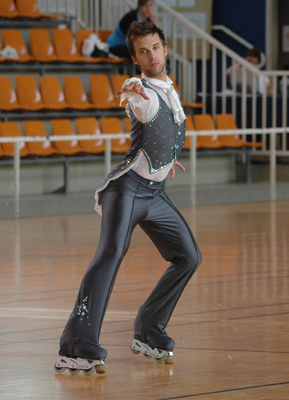
Artistic roller skating is a competitive sport similar to figure skating but where competitors wear roller skates instead of ice skates. Within artistic roller skating, there are several disciplines:
A mohawk is a figure skating turn that involves a change of skating foot but not a change of edge. It is a turn from one foot to the other, from forward to backwards in which the entry and exit curves are continuous and of equal depth.
A choctaw turn is a turn in figure skating that involves both a change of foot and a change of edge and lobe. Choctaws are the two-foot equivalents of rockers and counters, in the same way that mohawk turns are the two-foot equivalents of three turns and brackets.
A twizzle is "a multirotational, one-foot turn that moves across the ice" in the sport of figure skating. First performed by David Grant in 1990 the International Skating Union (ISU) defines a twizzle as "a traveling turn on one foot with one or more rotations which is quickly rotated with a continuous (uninterrupted) action". It is most often performed in ice dance, although single skaters and pair skaters also perform the element. Twizzles have been called "the quads of ice dance" because like quadruple jumps in other disciplines, twizzles are risky and technically demanding.
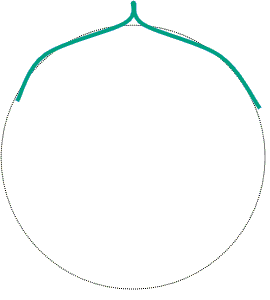
A bracket turn is a kind of one-foot turn in figure skating.
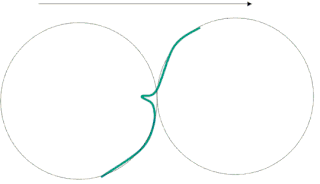
A rocker turn is a kind of one-foot turn in figure skating. Unlike three turns and brackets, where the entry and exit edges follow the same curve, in a rocker, the entry and exit are on opposite curves. When executing a rocker, the skater turns inward on the curve of the entry edge, but exits on a curve in the opposite sense. Another way to look at it is that a rocker is similar to the entry of a three turn combined with the exit of a bracket. In a rocker turn, the skating edge is maintained; for example, a rocker from a forward outside edge ends on a backward outside edge.
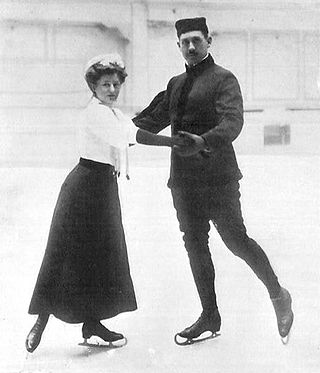
Pair skating is a figure skating discipline defined by the International Skating Union (ISU) as "the skating of two persons in unison who perform their movements in such harmony with each other as to give the impression of genuine Pair Skating as compared with independent Single Skating". The ISU also states that a pairs team consists of "one Woman and one Man". Pair skating, along with men's and women's single skating, has been an Olympic discipline since figure skating, the oldest Winter Olympic sport, was introduced at the 1908 Summer Olympics in London. The ISU World Figure Skating Championships introduced pair skating in 1908.
Moves in the field is a name given to elements of figure skating that emphasize basic skating skill and edge control. In the context of a competitive program, 'moves in the field' include spirals, spread eagles, Ina Bauers, hydroblading, and similar extended edge moves.
The following is a glossary of figure skating terms, sorted alphabetically.

The death spiral is a figure skating term used to describe a spin involving two partners in the discipline of pair skating, in which one partner lowers the other partner while the partner getting close to the ice arches backward on one foot. It was created by German professional skater Charlotte Oelschlägel and her husband Curt Newmann in the 1920s. Suzanne Morrow and Wallace Diestelmeyer from Canada were the first pair team to perform the death spiral one-handed, at the 1948 Olympic Games. In the 1960s, Soviet pair team Liudmila Belousova and Oleg Protopopov created three death spirals: "the backward-inside, forward-inside and forward-outside death spirals, which they originally named the Cosmic Spiral, Life Spiral and Love Spiral, respectively". The International Skating Union (ISU), the governing body that oversees figure skating, allows for variations of arm holds and pivot positions. Senior pair skating teams must perform different types of death spirals in their short programs and free skating programs.
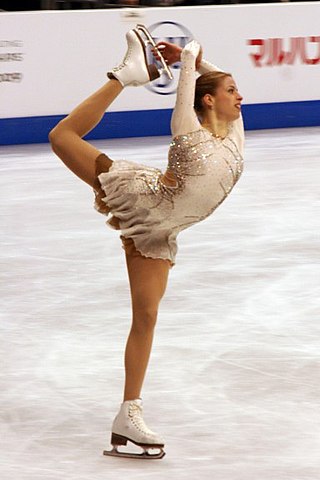
Single skating is a discipline of figure skating in which male and female skaters compete individually. Men's singles and women's singles are governed by the International Skating Union (ISU). Figure skating is the oldest winter sport contested at the Olympics, with men's and women's single skating appearing as two of the four figure skating events at the London Games in 1908.

Figure skating lifts are required elements in two disciplines of figure skating, pair skating and ice dance. There are five groups of lifts in pair skating, categorized in order of increasing level of difficulty. Judges look for the following when evaluating pair lifts: speed of entry and exit; control of the woman's free leg when she is exiting out of the lift, with the goal of keeping the leg high and sweeping; the position of the woman in the air; the man's footwork; quick and easy changes of position; and the maintenance of flow throughout the lift. Twist lifts are "the most thrilling and exciting component in pair skating". They can also be the most difficult movement to perform correctly. They require more strength and coordination than many other pair elements, and are usually the first or second element in a program. According to the International Skating Union (ISU), "the Woman must be caught in the air at the waist by the Man prior to landing and be assisted to a smooth landing on the ice on a backward outside edge on one foot" during a twist lift. A pair lift and twist lift is required in the short program of pair skating; a well-balanced free skating program in pair skating must include lifts.
British Ice Skating is the national governing body of ice skating within the United Kingdom. Formed in 1879, it is responsible for overseeing all disciplines of ice skating: figure skating ; synchronised skating; and speed skating.
A step sequence is a required element in all four disciplines of figure skating, men's single skating, women's single skating, pair skating, and ice dance. Step sequences have been defined as "steps and turns in a pattern on the ice". Skaters earn the most points in step sequences by performing steps and movements with "flair and personality", by turning in both directions, by using one foot and then the other, and by including up and down movements.
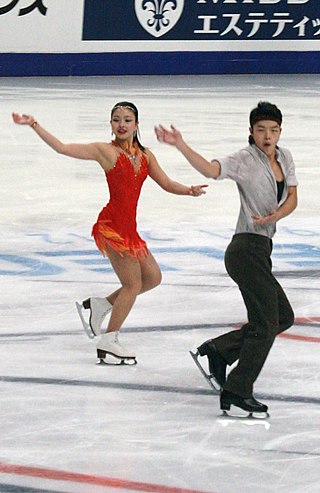
Ice dance, a discipline of figure skating, has required elements that make up a well-balanced rhythm dance program and free dance program, which must be performed during competitions. They include: the dance lift, the dance spin, the step sequence, turn sequences, and choreographic elements. The elements must be performed in specific ways, as described by published communications by the International Skating Union (ISU), unless otherwise specified. The ISU has also provided a list of illegal movements.









